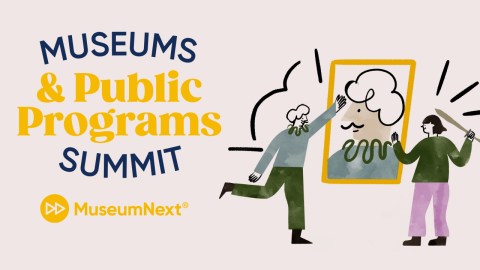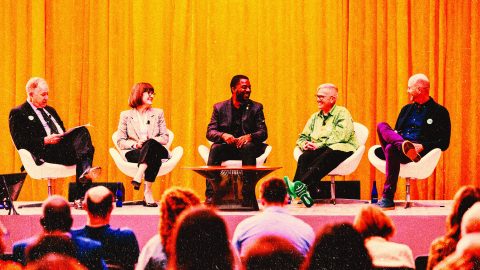Last week, Barbara Stauffer shared with us the challenges of orchestrating a participatory design experience in an institution with well-established organizational procedures and hierarchies. For her, inviting the input of over 800 community members involved a lot of time, finesse, diplomacy and sensitivity to organizational culture. Maria Mortati, project manager and senior exibit developer at Gyroscope Inc., took a different tack, founding the San Francisco Mobile Museum, giving her the freedom to experiment with many ways of making the audience part of the museum design experience.
Workingand Playing
In 2009, I was a museum exhibit developer in search of an audience. I had tested out an exhibit at a Maker Faire a year prior, had fun and learned a lot. Serving 60,000 people in 2 days is a great way to try something on for size.
 |
During my work travels the following year, I met Jaime Kopke, founder of the Denver Community Museum. The DCM was her brilliant, year-long community contributed project. We decided to collaborate on a dual-city exhibit challenge, and I needed a platform—the San Francisco Mobile Museum was born.
The Platform
The physical constraints of the Museums’ exhibit platform were that it had to fit in my car, be able to be set up within about an hour, and be made of reasonably sustainable materials. I designed it and a local furniture designer built it with some smart modifications. Our first show was called “Looking for Loci,” and it was based around the ancient Roman idea of “Genius Loci,” or special place.
The Exhibit
Online I found a resource for boxes that would be a reasonable size for people to work with, and for us to wrangle with while hanging. We put out a call to the citizens of our towns and challenged them to use a box as a way to convey the Genius Loci of a place in their city—specifying it could be part of their “home, in a park or garden, on a street corner, or just a forgotten place in the alley.”We mailed the boxes out with instructions, and folks mailed them back or dropped them off.
 Marcia Stuermer’s Looking for Loci
|
The exhibit toured around Denver for a few months and then San Francisco. I wanted to provide an on-the-spot way for visitors to contribute, so I added a map of the Bay Area and invited visitors to write notes on it. It all worked really well- people enjoyed encountering a museum unexpectedly, and seeing the variety of interpretations of place.
During the run of the show, I experimented with a variety of locations for the mobile museum. I found parks to be the best place to attract a diverse audience.It also was easier for folks to perceive it as a museum when it was outside, vs. linked to the place it was shown in when inside.

The SFMM in Dolores Park, San Francisco
|
Extending the Visitor Experience
In San Francisco, we photographed and posted the pieces on our blog, letting the contributor of that box write the post. Often I’d add contextual information about the maker, or let them do so. I don’t yet have a feel for the impact of these annotations, but I believe that it is important to document ephemeral work, for the makers and for the museum. Also, documenting their pieces helps people feel you’re taking their contributions seriously.
After the first exhibit, I wanted to play with a few things:
- Would it work to move away from a fixed format (the boxes) to an open format for contributions?
- Would it be helpful to have additional interpretation?
- How could I foster more meaningful on-the-spot contributions?
Tweaking the System
The following year I developed an exhibit called “Free Shrines,” exploring the history, meaning and spontaneous use of shrines.Contributors were invited to create a palm-sized shrine that embodied their idea of someone, a remembrance, an icon of joy, or a representation of a special wish. The first installation had three weeks to come together for a one-night show outside the Exploratorium, so it was a bit smaller in scope than “Genius Loci.”
 FREE Shrines at the Exploratorium
|
To my surprise, this open-format worked fine in terms of generating creative responses.But it made it more difficult to make this exhibit a comprehensible experience for visitors. The consistency of format helps people get the idea overall quickly when they are looking at a series in response to a single question. You can read an evaluation I wrote about that show on our blog.
The winning element by far was the improved design for the on-the-spot contributions, an “Ema shrine station”. As I suspected, honoring the contributions of folks by giving them an integrated design meant that they responded in kind.
What’s next?
I’m working on iterating the platform, playing with interpretation, and collaborating with other individuals and institutions. Think the next exhibit may not be a public “challenge” but about experimenting with using the SFMM to interpret where the location it’s at on a given day. I’ll post updates on the blog.
 Left: map at “Looking for Loci” Right: Ema shrine station at “FREE Shrines” |
What’s in it for Museums?
Working outside the political structure of a museum meant that I could work quickly—I was empowered to make decisions based on the needs of the project and the audience. Encountering a museum or abstract ideas presents interesting challenges, but they’re fairly easy to overcome with a little planning and design.
Museums have to move out of a mode of cultural protection to cultural production. I see a variety of ways such platforms could help both grand and humble institutions make this adjustment. Having a little in-house talent, time, and a willing cultural infrastructure could make all the difference.
To learn more about the SF Mobile Museum at the AAM Annual Meeting, join Maria and her fellow panelists at the session “’Future of Exhibiting: Voices from Nontraditional Museums” on Sunday, May 22 at 1:15 p.m.









Thanks for sharing, I will bookmark and be back again
Web Development San Francisco